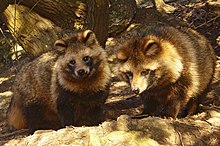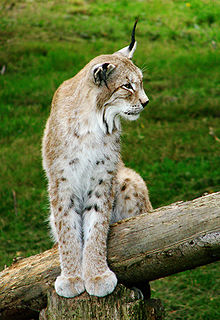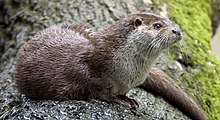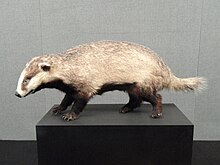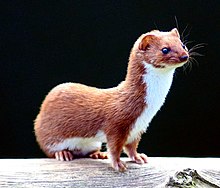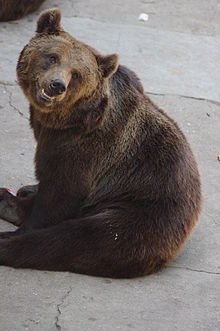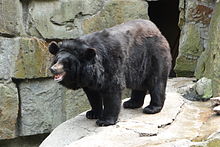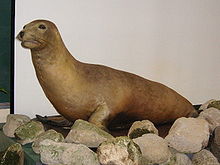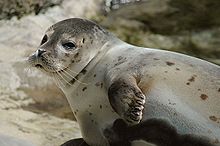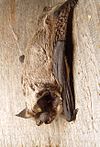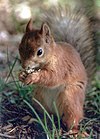Approximately 100 species of mammal are known to inhabit, or to have recently inhabited, the Korean Peninsula and its surrounding waters. This includes a few species that were introduced in the 20th century; the coypu was introduced for farming in the 1990s, and the muskrat was introduced in the early 20th century into the Russian Far East, and was subsequently first recorded in Korea in the Tumen River basin in 1965. The Siberian tiger is the national animal of South Korea. The Siberian tiger and Amur leopard have most likely been extirpated from Korea, but are still included in standard lists of Korean mammals.

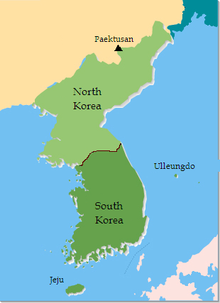


Most Korean mammal species are found only in a small part of Korea. The large southeastern island of Jeju, and the rugged northeastern Paektu Mountain region, are particularly known for their distinctive mammal species. Several species, including the Dsinezumi shrew, are found only on Jeju, while many other species, such as the wild boar, are absent or extirpated from there. Some mammals, such as the Manchurian wapiti, are considered natural monuments of North Korea, while others, such as the spotted seal, are considered natural monuments of South Korea.
Order Artiodactyla: even-toed ungulates
| Common name (Korean name) | Species (authority) | Preferred habitat | Range | Status[1] |
|---|---|---|---|---|
| Family Bovidae: bovids | ||||
| Aurochs
| Bos primigenius (Bojanus, 1827) | Dense forest | Historically throughout mainland[2] |
|
| Long-tailed goral
| Naemorhedus caudatus[3] (Hamilton Smith, 1827) | High mountains | Historically found throughout the Taebaek Mountains; northern Taebaek Mountains, including the Demilitarized Zone.[4] | |
| Family Cervidae: deer | ||||
| Siberian roe deer
| Capreolus pygargus (Pallas, 1771) | Forest verges | Throughout; not found on Ulleungdo | |
| Manchurian wapiti
| Cervus canadensis xanthopygus (H. Milne-Edwards, 1867) | Mixed and Deciduous forests | Once found throughout mainland[9]
| |
| Manchurian sika deer
| Cervus nippon mantchuricus (Temminck, 1838) | Open forest and forest verges | Throughout mainland[12] | |
| Water deer
| Hydropotes inermis (R. Swinhoe, 1870) | Low mountains and riparian areas; often visits urban areas | Throughout mainland |
|
| Family Moschidae: musk deer | ||||
| Siberian musk deer
| Moschus moschiferus (Linnaeus, 1758) | Mountain forest | Historically throughout mainland; North Korea; also found in Gangwon, South Korea | |
| Family Suidae: pigs | ||||
| Wild boar
| Sus scrofa ussuricus (Linnaeus, 1758) | Mountain forest | Throughout mainland |
|
Order Carnivora: carnivores
| Common name (Korean name) | Species (authority) | Preferred habitat | Range | Status[1] |
|---|---|---|---|---|
| Family Canidae: canids | ||||
| Grey wolf (늑대) | Canis lupus (Linnaeus, 1758) | Forests and open woods | Historically throughout mainland; currently Paektu Mountain area | |
| Dhole (승냥이) | Cuon alpinus (Pallas, 1811) | Dense forest and high mountains | Historically throughout mainland | |
| Raccoon dog (너구리) | Nyctereutes procyonoides (Gray, 1834) | Wooded valleys | Throughout mainland |
|
| Red fox (여우) | Vulpes vulpes (Linnaeus, 1758) | Brushy areas and forest verges | Historically throughout mainland; northern and northeastern Korea | |
| Family Felidae | ||||
| Leopard cat (삵) | Prionailurus bengalensis (Kerr, 1792) | Dense forest | Historically throughout mainland; central and northern Korea, with major population in DMZ | |
| Eurasian lynx (스라소니) | Lynx lynx (Linnaeus, 1758) | Montane forest | Historically throughout mainland; North Hamgyong and Chagang, North Korea | |
| Leopard (표범) | Panthera pardus (Linnaeus, 1758) | High dense forest | Historically throughout mainland; possibly North Korea |
|
| Tiger (호랑이) | Panthera tigris (Linnaeus, 1758) | Rocky forest | Historically throughout the mainland; possibly northeastern North Korea |
|
| Family Mustelidae: mustelids | ||||
| Eurasian otter (수달) | Lutra lutra (Linnaeus, 1758) | Riparian areas | Throughout mainland, scattered | |
| Yellow-throated marten (담비) | Martes flavigula (Boddaert, 1785) | High forest | Northern Korea and parts of central and southern Korea: historically throughout mainland Korea | |
| Sable (검은담비) | Martes zibellina (Linnaeus, 1758) | High, dense boreal forest | North Hamgyong, northeastern North Korea | |
| Asian badger (오소리) | Meles leucurus (Hodgson, 1847) | Forests and mountain valleys. Fossorial. | Throughout mainland | |
| Least weasel (무산쇠족제비) | Mustela nivalis (Linnaeus, 1758) | Subalpine areas | Far northeastern and northwestern North Korea;[39] also northern South Korea |
|
| Siberian weasel (족제비) | Mustela sibirica (Pallas, 1773)[40] | Forests and riparian areas | Throughout, including Jeju[39] |
|
| Family Ursidae: bears | ||||
| Brown bear (불곰) | Ursus arctos (Linnaeus, 1758) | Thick forest | Central and northern Korea; likely extirpated | |
| Asian black bear (반달가슴곰) | Ursus thibetanus (G. Cuvier, 1823)[44] | Thick forest | Historically found throughout mainland; Jirisan and Seoraksan in South Korea; Mount Kumgang and Paektu Mountain in North Korea | |
| Superfamily Pinnipedia: pinnipeds | ||||
| Common name (Korean name) | Species (authority) | Preferred habitat | Range | Status[1][47] |
| Family Otariidae: eared seals | ||||
| Northern fur seal (물개) | Callorhinus ursinus (Linnaeus, 1758) | Coasts and seas | Sea of Japan | |
| Steller sea lion (큰바다사자) | Eumetopias jubatus (Schreber, 1776) | Coasts and seas | Northern Yellow Sea and Sea of Japan | |
| Japanese sea lion (강치) | Zalophus japonicus (Peters, 1866) | Coasts and seas | East China Sea, Korea Strait, Sea of Japan |
|
| Harbor seal (잔점박이물범) | Phoca vitulina (Linnaeus, 1758) | Coasts and seas | Northern Sea of Japan | |
| Spotted seal (점박이물범) | Phoca largha {{small(Pallas, 1811)}} | Coasts and seas | Throughout Yellow Sea, Sea of Japan, and Korea Strait; large colony on Baengnyeongdo | |
Order Cetacea: whales
| Common name (Korean name) | Species (authority) | Preferred habitat | Range | Status[1] |
|---|---|---|---|---|
| Suborder Mysticeti: baleen whales | ||||
| Family Balaenidae: right whales | ||||
| North Pacific right whale
| Eubalaena japonica (Lacépède, 1818) | High reliance on coastal waters | Sea of Japan, Korea Strait, Yellow Sea, East China Sea (wiped out by Japanese, Soviet, and American whalers)
|
|
| Bowhead whale
| Balaena mysticetus (Linnaeus, 1758) | Coastal and frozen waters | Sea of Okhotsk | |
| Family Eschrichtiidae: gray whales | ||||
| Gray whale
| Eschrichtius robustus (Lilljeborg, 1861) | Migratory through coastal waters | Sea of Japan, Korea Strait, Yellow Sea, East China Sea (wiped out by Japanese whalers)
| *I: LC Endangered
|
| Family Balaenopteridae: rorquals | ||||
| Humpback whale
| Megaptera novaeangliae (Borowski, 1781) | Coastal waters, often penetrates estuaries | Very small numbers in Sea of Japan and Korea Strait and Yellow Sea, seasonally residents in East China Sea
|
|
| Minke whale
| Balaenoptera acutorostrata (Lacépède, 1804) | Widespread | Yellow Sea,[90] East China Sea, Sea of Japan
| |
| Blue whale
| Balaenoptera musculus (Linnaeus, 1758) | Widespread but less common in Mediterranean seas (smaller numbers historically migrated into both sides of Korean Peninsula)[92] | Regarded as being almost/already extinct in east Asian waters[93]
| |
| Fin whale
| Balaenoptera physalus (Linnaeus, 1758) | Coastal waters | Coastal groups in northeast Asian waters, along with many other baleen species, were likely driven into serious perils or functional extinctions by industrial catches by Japan covering wide ranges of China and Korean EEZ within very short period in 20th century.[97]
|
|
| Bryde's whale and Eden's whale[107]
| Balaenoptera brydei Balaenoptera edeni | Widespread in both coastal and pelagic waters | Yellow Sea (possibly), East China Sea, Sea of Japan |
|
| Omura's whale
| Balaenoptera omurai | Widespread in both coastal and pelagic waters | East China Sea, Sea of Japan
| |
| Sei whale
| Balaenoptera borealis | Widespread | Yellow Sea,[109] East China Sea, Sea of Japan |
|
| Suborder Odontoceti: toothed whales | ||||
| Family Delphinidae: oceanic dolphins | ||||
| Short-beaked common dolphin
| Delphinus delphis (Linnaeus, 1758) | Warmer coastal waters | Throughout |
|
| Common bottlenose dolphin
| Tursiops truncatus | Warmer coastal and open waters | Throughout | |
| Indo-Pacific bottlenose dolphin
| Tursiops aduncus | Warmer coastal waters | Endangered, resident at Jeju Island | |
| Striped dolphin
| Stenella coeruleoalba | Warmer coastal and open waters |
| |
| Fraser's dolphin
| Lagenodelphis hosei | Warmer coastal waters | Vagrant | |
| Pacific white-sided dolphin
| Sagmatias obliquidens (Gill, 1865) | Warmer coastal waters | Sea of Japan[111] | |
| Risso's dolphin
| Grampus griseus | Coastal and open seas | Sea of Japan, Korea Strait, East China Sea | |
| Family Globicephala: pilot whales | ||||
| Short-finned pilot whale
| Globicephala macrorhynchus | Open seas | Sea of Japan, Korea Strait, East China Sea |
|
| False killer whale
| Pseudorca crassidens | Coastal and open seas | Sea of Japan, Korea Strait, East China Sea |
|
| Pygmy killer whale
| Feresa attenuata | Coastal and open seas | Korea Strait, East China Sea | |
| Killer whale
| Orcinus orca (Linnaeus, 1758) | Coastal waters | Throughout (reduced by Japanese whalers) |
|
| Beluga
| Delphinapterus leucas (Pallas, 1776) | Coastal waters | Vagrant from the Sea of Okhotsk[114] |
|
| Family Phocoenidae: porpoises | ||||
| Dall's porpoise
| Phocoenoides dalli
| Colder ocean waters | North of the 35th parallel in the Sea of Japan | |
| Harbour porpoise
| Phocoena phocoena (Linnaeus, 1758) | Colder ocean waters | Sea of Japan | |
| Finless porpoise
| Neophocaena phocaenoides (Cuvier, 1829) | Coastal waters | Yellow Sea (such as at Baengnyeongdo), Korea Strait, southern Sea of Japan |
|
| Family Physeteridae: sperm whales | ||||
| Sperm whale
| Physeter macrocephalus (Linnaeus, 1758) | Deep oceans | Korea Strait, East China Sea, Sea of Japan (in small numbers) | |
| Family Ziphiidae: beaked whales | ||||
| Giant beaked whale
| Berardius bairdii (Stejneger, 1883) | Open seas | Sea of Japan (reduced by Japanese whalers) | |
| Cuvier's beaked whale
| Ziphius cavirostris | Open seas | Sea of Japan, East China Sea | |
| Ginkgo-toothed beaked whale
| Mesoplodon ginkgodens | Open seas | Sea of Japan, Jeju,[121] East China Sea, Yellow Sea[122] | |
Order Erinaceomorpha: hedgehogs
| Common name (Korean name) | Species (authority) | Preferred habitat | Range | Status[1] |
|---|---|---|---|---|
| Family Erinaceidae: hedgehogs | ||||
| Amur hedgehog
| Erinaceus amurensis (Schrenk, 1859) | Deciduous and mixed forests[123] | Throughout mainland |
|
Order Soricomorpha: shrews and moles
| Common name (Korean name) | Species (authority) | Preferred habitat | Range | Status[1] |
|---|---|---|---|---|
| Family Talpidae: moles | ||||
| Japanese mole
| Mogera wogura[124] (Temminck, 1833) | High moist forest | Throughout mainland; not found on Jeju or Ulleungdo |
|
| Family Soricidae: shrews | ||||
| Dsinezumi shrew
| Crocidura dsinezumi (Temminck, 1842) | Damp forest and grassland | Found only on Jeju[125] |
|
| Ussuri white-toothed shrew
| Crocidura lasiura (Dobson, 1890) | Widespread | Throughout mainland |
|
| Lesser white-toothed shrew
| Crocidura suaveolens (Pallas, 1811) | Moist deciduous forest | Throughout, including Ulleungdo[126] |
|
| Eurasian water shrew
| Neomys fodiens (Pennant, 1771) | Riparian areas and mountain lakes[126] | Northern North Korea.[127] |
|
| Laxmann's shrew
| Sorex caecutiens (Laxmann, 1788) | Rugged mountains | Northern and northeastern North Korea.[128] | |
| Siberian large-toothed shrew
| Sorex daphaenodon (Thomas, 1907) | Boreal forest and alpine meadows | Paektusan region.[129] | |
| Slender shrew
| Sorex gracillimus (Thomas, 1907) | Coniferous forest and alpine regions | Northeastern North Korea.[130] |
|
| Taiga shrew
| Sorex isodon (Turov, 1924) | Mountain forest | Baekdudaegan mountains.[132] | |
| Eurasian least shrew
| Sorex minutissimus (Zimmermann, 1780) | Rugged mountains bove 1500 meters[133] | Central and northern Korea.[134] |
|
| Ussuri shrew
| Sorex mirabilis (Ognev, 1937) | Moist ground above 1500 meters[133] | Central and northern Korea |
|
| Long-clawed shrew
| Sorex unguiculatus (Dobson, 1890) | High moist areas | Northeastern North Korea.[135] |
|
Order Chiroptera: bats
| Common name (Korean name) | Species (authority) | Preferred habitat | Range | Status[1] |
|---|---|---|---|---|
| Family Rhinolophidae: horseshoe bats | ||||
| Greater horseshoe bat
| Rhinolophus ferrumequinum (Schreber, 1774) | Roosts in caves and abandoned mines | Scattered throughout, including Jeju | |
| Family Vespertilionidae: vesper bats | ||||
| Kobayashi's bat
| Eptesicus koyabashii (Mori, 1928) | West central Korea.[138] |
| |
| Northern bat
| Eptesicus nilssonii (Keyserling & Blasius, 1839) | Found in Gyeonggi, northwestern South Korea, and North Hamgyong, northeastern North Korea |
| |
| Serotine bat
| Eptesicus serotinus (Schreber, 1774) | Roosts in roofs and walls | Most common in northwestern Korea |
|
| Savi's pipistrelle
| Hypsugo savii[141] (Bonaparte, 1837) | Roosts in caves[142] | Throughout |
|
| Common bent-wing bat
| Miniopterus schreibersi (Kuhl, 1817) | Grassland and forest in summer; caves in winter | Scattered throughout |
|
| Little tube-nosed bat
| Murina aurata (Milne-Edwards, 1872) | Unknown |
| |
| Greater tube-nosed bat
| Murina leucogaster (Milne-Edwards, 1872) | Unknown.[145] |
| |
| Far Eastern myotis
| Myotis bombinus[146] (Thomas, 1906) | Hibernates in caves | Throughout, including Jeju |
|
| Daubenton's bat
| Myotis daubentonii (Kuhl, 1817) | Near water | Throughout, including Jeju |
|
| Hodgson's bat
| Myotis formosus (Hodgson, 1835) | Scattered throughout; not found on Jeju[148] | ||
| Fraternal myotis
| Myotis frater (G.M. Allen, 1923) | Forests | Northern Korea.[149] |
|
| Ikonnikov's bat
| Myotis ikonnikovi (Ognev, 1912) | Scattered throughout, including Jeju |
| |
| Eastern long-fingered bat
| Myotis macrodactylus (Temminck, 1840) | Local throughout, including Jeju | ||
| Whiskered bat
| Myotis mystacinus (Kuhl, 1817) | Forests | Scattered throughout, including Jeju and Ulleungdo[152] | |
| Birdlike noctule
| Nyctalus aviator (Thomas, 1911) | Scattered throughout | ||
| Java pipistrelle
| Pipistrellus javanicus[154]
| Scattered throughout |
| |
| Brown long-eared bat
| Plecotus auritus (Linnaeus, 1758) | High mountains | The Taebaek Mountains and the Paektusan area in northern North Korea | |
| Particoloured bat
| Vespertilio murinus (Linnaeus, 1758) | High forest and grassland in the summer | North Hamgyong, North Korea |
|
| Asian particolored bat
| Vespertilio superans (Thomas, 1899) | West central Korea.[155] |
| |
Order Lagomorpha: lagomorphs
| Common name (Korean name) | Species (authority) | Preferred habitat | Range | Status[1] |
|---|---|---|---|---|
| Family Leporidae: leporids | ||||
| Korean hare
| Lepus coreanus (Thomas, 1892) | Widespread at low altitudes.[156] | Throughout mainland.[157] |
|
| Manchurian hare
| Lepus mandschuricus (Radde, 1861) | High rocky forest | Northern Korea |
|
| Family Ochotonidae: pikas | ||||
| Northern pika
| Ochotona hyperborea (Pallas, 1811) | Alpine meadows, 1000–2500 m. | Northern Korea |
|
Order Primates: prosimians and simians
| Common name (Korean name) | Species (authority) | Preferred habitat | Range | Status[1] |
|---|---|---|---|---|
| Family Hominidae: great apes | ||||
| Human
| Homo sapiens (Linnaeus, 1758) | Widespread | Throughout |
|
Order Rodentia: rodents
| Common name (Korean name) | Species (authority) | Preferred habitat | Range | Status[1] |
|---|---|---|---|---|
| Family Muridae: murids | ||||
| Striped field mouse
| Apodemus agrarius (Pallas, 1771) | Widespread | Throughout, including Jeju[159] | |
| Jeju striped field mouse
| Apodemus chejuensis[161] (Jones & Johnson, 1965) | Widespread | Found only on Jeju | |
| Korean field mouse
| Apodemus peninsulae (Thomas, 1907) | Forest verges and brushland | Throughout mainland |
|
| Eurasian harvest mouse
| Micromys minutus (Pallas, 1771) | Low grasslands and fields | Throughout; not found on Ulleungdo | |
| House mouse
| Mus musculus (Linnaeus, 1758) | Human dwellings | Throughout | |
| Brown rat
| Rattus norvegicus (Berkenhout, 1769) | Urban and cultivated areas | Throughout |
|
| Black rat
| Rattus rattus (Linnaeus, 1758) | Urban areas | Central and southern Korea | |
| Family Cricetidae: cricetids | ||||
| Northern red-backed vole
| Myodes rutilus (Pallas, 1779) | High, dense mixed forest | Far northeastern Korea | |
| Grey red-backed vole
| Myodes rufocanus[167] (Sundevall, 1846) | Boreal forest | Northern Korea | |
| Chinese striped hamster
| Cricetulus barabensis (Pallas, 1773) | Fields | Sinuiju and Cholsan, North Korea |
|
| Royal vole
| Eothenomys regulus (Thomas, 1907) | Widespread; avoids deep forest | Southern, central and northwestern Korea |
|
| Mandarin vole
| Lasiopodomys mandarinus[172] (Milne-Edwards, 1871) | Grassy wetlands | Southwestern Korea |
|
| Reed vole
| Microtus fortis (Büchner, 1889) | High fields and forest verges | Western and northern Korea |
|
| Muskrat
| Ondatra zibethicus (Linnaeus, 1766) | Marshes and lakes | Tumen River basin, North Korea.[173] | |
| Greater long-tailed hamster
| Tscherskia triton (de Winton, 1899) | Widespread | Throughout, including Jeju[170] |
|
| Family Myocastoridae: coypu | ||||
| Coypu
| Myocastor coypus
| Wetlands | South Korea's Yeongnam region (Introduced for farming in the 1990s) | |
| Family Sciuridae: squirrels | ||||
| Siberian flying squirrel
| Pteromys volans (Linnaeus, 1758) | Boreal forest | Far northeast and Taebaek Mountains |
|
| Red squirrel
| Sciurus vulgaris (Linnaeus, 1758) | Forests | Throughout mainland[177] |
|
| Siberian chipmunk
| Tamias sibiricus (Laxmann, 1769) | Forests | Inland throughout |
|
| Family Dipodidae: jumping mice | ||||
| Long-tailed birch mouse
| Sicista caudata (Thomas, 1907) | Riparian zones and wetlands | Northeastern Korea[178] |
|
See also
Notes
References and further reading
- Bergsten, C. Fred; In-bŏm Chʻoe (2003). The Korean Diaspora in the World Economy. Washington, DC: Peterson Institute. ISBN 0-88132-358-6.
- Han Sang-hun (한상훈) (1998). "사라져가는 한국의 야생 포유동물 [Sarajyeoganeun han-guk-ui yasaeng poyudongmul / Korea's vanishing wild mammals]". Archived from the original on 2007-09-27. Retrieved 2006-09-29.
- Won, Pyong-Hooi (원병희) (1967). 한국동식물도감, 7권: 포유류 [Han-guk dongsingmul dogam 7gwon: poyuryu / Guide to Korea's plants and animals, vol. 7: Mammalia]. Seoul: Ministry of Culture and Education.
- 윤명희, 한상훈; 오홍식, 김장근; Won, Byeong-o (원병오) (2004). 한국의 포유동물 [Hangugui poyudongmul] [English title: The Mammals of Korea]. Seoul: Dongbang Media. ISBN 89-8457-310-8.
- Won, Changman; Kimberly G. Smith (1999). "History and current status of mammals of the Korean Peninsula". Mammal Review. 29 (1). Mammal Society: 3–36. doi:10.1046/j.1365-2907.1999.00034.x.









